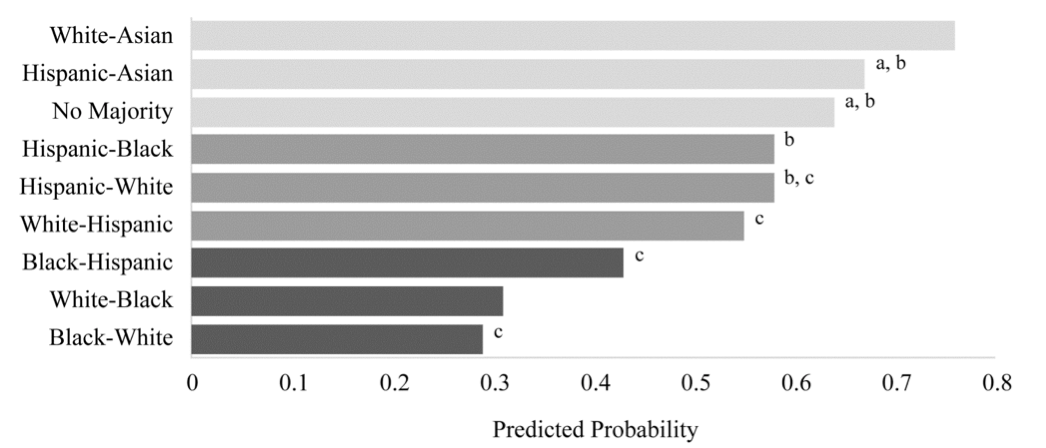Photo: Flickr user I-5 Design and Manufacture.
By 2050, the United States is expected to be roughly 46 percent white, 30 percent Hispanic and 12 percent black, according to Rice University's Hobby Center for the Study of Texas.
Meanwhile Texas's own demographics are ahead of the curve, clocking in at 45 percent white, 38 percent Hispanic and 12 percent black back in 2010.
But despite that diversity, historically, sociologists and others who study inequality have focused largely on disparities between just two groups, whites and blacks.
A new study co-written by Kinder Institute researchers and published in the journal Race and Social Problems suggests that method is likely outdated, given the shifting demographics of the country. Too often, the discussion leaves out the huge, and growing, Hispanic population group.
The typical black-white way of studying inequality may have "outlived its relevance" and needs to be reassessed, write Kinder Institute research fellow Heather O'Connell, Rice University associate sociology professor Jenifer Bratter and Lester King, a researcher with Houston Sustainability Indicators Project at Rice University in the paper titled "Community Resources in a Diverse City: Supermarket Location and Emerging Racial Hierarchies."
Focusing on access to supermarkets in Houston, the researchers assessed how Houston's large Hispanic population fit into the better-documented black-white disparities.
Houston's demographic transformation provided the perfect testing ground. The city transitioned "from an essentially biracial Southern city into the single most ethnically and culturally diverse large metropolitan region in the nation," as the Kinder Houston Area Survey puts it. The city is roughly 44 percent Hispanic, 26 percent white, 23 percent black and 6 percent Asian, according to the latest census estimates.
Supermarket access has consistently served as a "symbol of neighborhood quality and community-investment," the report explains. Others agree. The Houston Grocery Access Task Force, convened by the city as a public-private response to inequalities, has also highlighted supermarkets' connection to community health, housing values and employment opportunities.
"Many communities that are underserved by supermarkets also lack other important amenities and services needed to attract and retain retail investment, such as sidewalks, lighting and good transportation networks," a 2012 report from the task force concluded.
In their analysis, the Rice University researchers focused on large grocery stores that had a payroll of at least 50 workers, chain name recognition, and at least $2 million in annual sales. That approach often excludes smaller stores and ethnic markets, they acknowledged, but was consistent with efforts to examine whether an area was receiving significant external investment.
They found that white-black disparities persisted when it came to supermarket access, "even after accounting for local differences in economic composition."
"Increasing racial [and] ethnic diversity, even in Houston, is not erasing the social consequences of race in our society," said O'Connell.
But the report also found a more detailed breakdown of disadvantage in what it described as a "tri-racial system."
Using data from the American Community Survey, the 2010 census and 2010 business listings of big-name supermarkets, the researchers categorized neighborhoods by the racial/ethnic majority in each areas, as well as the second-largest racial or ethnic group. They would up with pairings like white-Asian or Hispanic-black.
Overall, roughly half of Houston's block groups are within a half-mile of a supermarket. But, because of clustering, they're not evenly spread throughout the city. "This clustering leaves some areas of the city with relatively less investment, particularly when comparing the southern and northeastern portions of the city with the northwestern corner of the city," the authors explain.
That's where the neighborhood categories come in. The most consistent predictor of a neighborhood not having access to a supermarket is the size of its black population. Communities that were majority white with Asians as the second-most populous group were the most likely to have a supermarket within walking distance. They were followed by Hispanic majority neighborhoods that had a sizable Asian population, then by neighborhoods with no majority.
The researchers identified these three types of neighborhoods as the most advantaged in terms of supermarket access. At the bottom of the list were black-Hispanic, white-black and black-white communities.
After controlling for median income, population and land size, intersection density, percentage of people with a college degree and the concentration of retail jobs, the researchers found that 80 percent of neighborhoods with a majority of white residents followed by Asian residents were expected to have a supermarket within a half mile, compared to only 30 percent of neighborhoods with a majority of black residents followed by white residents.
 The predicted probability that each neighborhood will have a supermarket within a half mile.
The predicted probability that each neighborhood will have a supermarket within a half mile.
In the middle, the researchers found a third tier of stratification for largely Hispanic communities. The findings also point to substantial differences even among majority white spaces. So, while a neighborhood dominated by white and Asian populations is most likely to have a supermarket nearby, a white-majority neighborhood where black residents made up the second largest group is one of the least likely to have a supermarket within a half-mile.
"What this tri-racial system tells us is that social stratification is happening along multiple racial and ethnic lines and to somewhat differing degrees depending on the group," said O'Connell.



